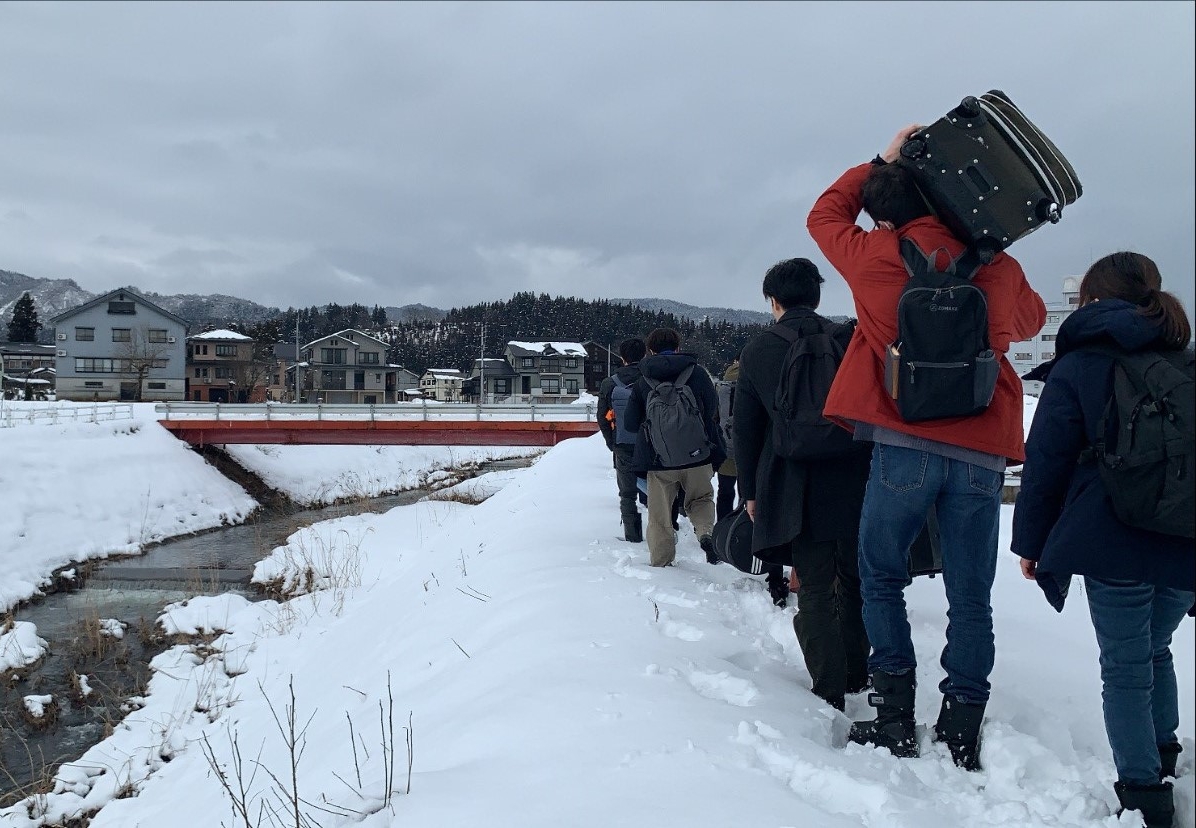Waseda Students on Break Part 2 – Snow Country Experience Project
Thu, Mar 19, 2020-
Tags
“Here check this out,” said a friend of Jessel Alvarez-Reveles, handing her a flyer. Jessel is a Center of Japanese Language (CJL) student from California. She came to Japan in September of last year and got involved with the two international circles on campus, Waseda International Circle (WIC) and Niji no Kai. The friend that had given her the flyer was with WIC. Jessel looked the flyer over, it was for a program called, “Snow Country Experience Project.” For Seven days, participants would be living in a dormitory, interacting with native Japanese speakers, and eating traditional foods. In exchange they would help teach kids English and shovel snow. It seemed like an interesting opportunity but then her eyes fell to the bottom of the page. The program was ¥30000 (about $300). As interesting as the program was, she would not be able to afford it.
A few days later, another friend contacted her. He asked if she was interested in the Snow Country Experience Project. She was interested but she had not pursued it further, reconciling herself to the fact that she could not afford the trip. Her friend had gone to the orientation for the trip to investigate it further. He too had been concerned about the price and when he inquired, the organizers said not to worry. They had received a grant allowing them to take on more students at a discount. Delighted, he, Jessel and a few other friends signed up. The new cost of the program was ¥2,800 (about $28)! The price included lodging, breakfast and dinner, group activities, and transportation. She was astounded. For the cost of 2 meals, she would be able to go on a week-long adventure.
Early on a Saturday morning, Jessel got ready and departed for Shinjuku Station. From there, she, her friends, and other Waseda Students travelled to Niigata Prefecture by shinkansen (bullet train). They arrived around noon, had lunch and were given time to settle in and relax. She would be staying at Matsuo dormitory with 4-6 girls per room. The number of people in each room fluctuated throughout the week as not everyone had signed on to stay for the whole week. Some had to go back for work, job hunting, or other responsibilities. She was assigned to a warm, traditional style room, and they were given futons to use during their stay. She had expected the futon to be uncomfortable but, she was pleasantly surprised to discover they were soft and provided adequate padding.
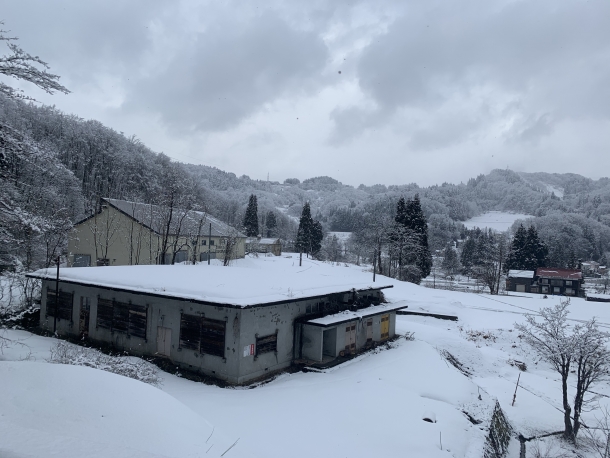
View from a dormitory window
Once they were all settled in, they went to an art museum and got to try on wide brimmed straw hats that shielded the wearer from the snow. Her friends also tried on a straw cape that people used to wear for additional protection from the elements. That night, they were served a wonderful dinner and the lady who had prepared it came out and gave each student a beautiful drawstring bag, much like a kimono bag. The lady had made each one and Jessel felt grateful to receive a gift that had been so lovingly made.
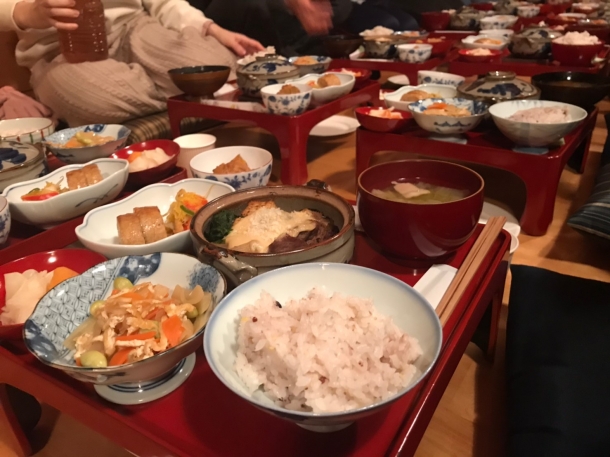
Dinner on the first night
After dinner, they were given an orientation and were told about the different ways of historically removing snow in the region. They learned about the equipment they would be using, including snowshoes which were made of an oblong wooden frame with string woven across the opening of the frame. One would then place one’s feet in the middle of the frame then tie the frame to their shoes. In so doing, weight was evenly distributed over a wider surface area, preventing the wearer from sinking into the snow.
The following day, she met the four tween students she would be teaching English to. Each of the volunteers introduced themselves and taught the children about their home countries. Some of the volunteers were from Portugal, South Korea, America, and some were locals from Japan. Jessel, being Mexican-American, was also able to teach the kids about Mexico. After lunch, they headed out into the snow and got to try snow shoveling firsthand.
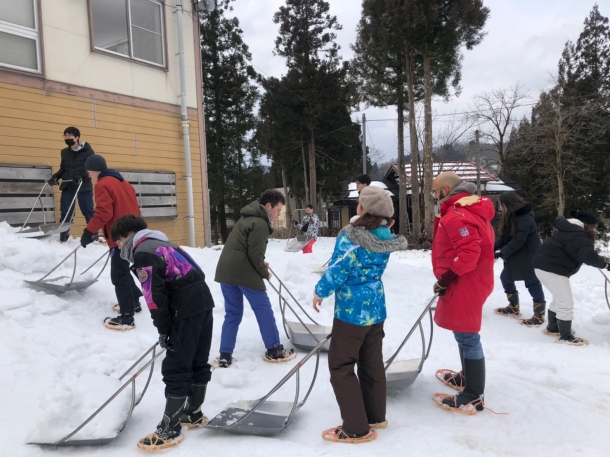
Volunteers shoveling snow with snowshoes tied onto their regular shoes
It was a lot of work. The snow was heavy and there was plenty of it. With the additional weight of their winter clothing that limited their movements, the simple task soon became a workout, exerting one’s arms and legs. After dinner, they prepared for the lessons of the following day then went to sleep, worn out.
The following morning, they played games with the children, doing Simon Says and a simplified version of the concentration game. The kids enjoyed it and they were able to practice some of their English. In the afternoon, they made Anbo, a dessert like mochi balls with sweet red bean paste filling. It was another new experience and Jessel was glad to have the opportunity to try her hand at making a Japanese dessert. They then went to an onsen to relax. As they soaked in the warm water, they could see the beautiful snow capped mountains in the distance. Afterward, they went back to the dorm to pack an overnight bag, then headed out for a homestay experience.
When she had signed up, Jessel had not known that homestay was part of the program. Living in a shared house, she had never tried homestay before. The house she was going to be staying at was a beautiful 100-year-old house. When they got to the home, they were warmly greeted by an older gentleman. She was there with two other Waseda students. The man welcomed them in and showed them how to make tofu. He had soybeans prepared ahead of time. They placed the soaked beans into a juicer which separated the pulp from the juice. Jessel thought that the man would then use the pulp to make tofu, however, he used the juice instead. It was a fascinating process which the man completed on his own while the students made amazake, a sweet low-alcohol drink made from rice, with apple slices. Still full from the anbo, they had a late dinner. It consisted of seafood abe, fish cake, octopus, clam, cabob, tofu, carrots, and vegetable tempura. Being sensitive to certain tastes, Jessel often stayed away from seafood and certain vegetables. However, not wanting to cause offence and wanting to push her boundaries and experiences past what she was comfortable with, she tried the food anyway. After dinner, they talked late into the night. All the conversations were in Japanese and even though Jessel isn’t fluent, it was really nice to try and practice the phrases she did know.
The following day for breakfast, they had the tofu they helped make. The floor of the room they were in was made of tatami, woven mats, with an irori, a sunken fireplace, in the middle. The man toasted rice balls over the open fire and they ate that with some miso paste. They talked for another hour or so, said their goodbyes, then headed back to their dorm.
That afternoon, they did more snow shoveling, had dinner and spent time with their fellow volunteers. The next day went by quickly as they played dodgeball, badminton, and volleyball at a nearby gym. They played with elementary school students and Jesse’s team won all the games they played. In one of the games, Jessel was tasked with running the last leg of a race. The object was to run around a course indicated by cones while balancing a ball on a piece of paper. As she came up on the final stretch, the kids cheered her on, shouting out encouragements in Japanese. Out of the corner of her eye, she could see a figure gaining on her. She pushed forward, going as fast as she dared without dropping the ball. She ran and crossed the finish line before anyone else. They cheered together, celebrating as a team.
That night, they had a lovely dinner and several important looking people, and their host’s parents were present. At the middle of the dinner, each of the important looking persons stood up and gave a speech. Jessel thought that they would be the only people giving speeches. However, all the first-time volunteers were also asked to speak. In her best Japanese, she gave a self-introduction and tried to convey how much she enjoyed the trip, how grateful she was, and how glad she was to have been given the opportunity to try this new experience. Coming from an area that doesn’t have snow, everything was new to her. Beyond the snow experience, she was also able to teach children, try homestay, and eat delicious Japanese food. During this trip she had pushed her boundaries, stepping outside of her comfort zone in so many ways. “I wish I knew more Japanese,” said Jessel during her interview, “so that I could communicate how much this trip meant to me and how grateful I am to have this opportunity.” Two days later, they packed up their futons, returned their snow gear, and set off for the station.
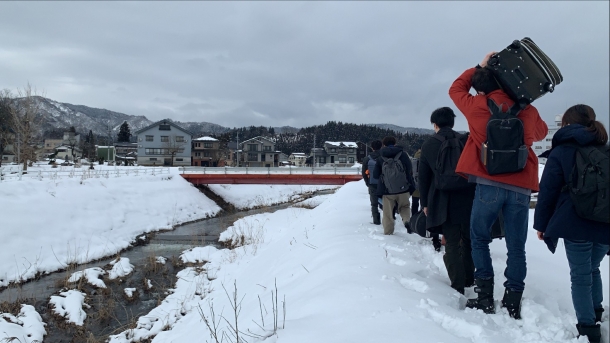
Volunteers walking to a train station through the snow with their luggage
When asked why Jessel chose to come to Japan, she said that it was because she wanted to learn Japanese, experience more of the culture, learn about the nation’s history, and make meaningful connections. Going on this trip allowed her to achieve all of those things. She was able to practice her Japanese with native speakers, give a speech in Japanese, and try homestay. She was also able to learn more about Japanese culture, the different foods, and specialties specific to Niigata prefecture. She also learned about different ways to clear snow throughout the history of the area. She was able to spend more time with her friends from Waseda, make new friends with international students, and form relationships with Japanese children, college students, and adults. She is grateful to have gone and that Waseda has programs like this that students can participate in.
Trip Summary
Lessons Learned:
- If something catches your interest, look into it even if there is some sort of hindrance. In Jessel’s case, she could not afford the cost of the trip. However, because her friend investigated further, they were able to use a grant that subsidized their trip.
- Try new foods. Even if you don’t like certain meats, vegetables, or ingredients, still give it a try. You might enjoy that particular ingredient when it is prepared differently. When Jessel tried the foods her host dad made, she ended up liking some of the things she tried and others she still didn’t enjoy. Either way, at least she gave it a try.
- Don’t be embarrassed. Even though Jessel only knew a little Japanese, she still tried to practice. Speaking in an unfamiliar language takes a lot of courage and you’ll make a lot of mistakes along the way. The key is to keep going and trying over and over even if you feel shy or embarrassed.
Location: Niigata Prefecture
Length of Stay: 7 days, 6 nights
Accommodation: Traditional style dormitory
Itinerary:
Day 1:
Morning
- Travel to Niigata from Shinjuku Station
- Arrived at noon
Afternoon
- Lunch
- Relax, unpack, settle in
- Art Museum
Evening
- Dinner
- Orientation and presentation on the history of snow removal
- Waseda students practice for the following day’s presentations to English students
Day 2:
Morning
- Breakfast
- English presentations (self-introduction, cultural background, greetings in English)
Afternoon
- Lunch
- Snow shoveling
Evening
- Dinner
- Plan English games for the next day’s lesson
Day 3:
Morning
- Breakfast
- For English lesson, played Simon Says and a simplified version of Concentration Game
Afternoon
Lunch
- Anbo making
- Onsen
- Returned to dorm to pack an overnight bag
Evening
- Travelled to homestay
- Made Tofu and amazake
- Dinner
- Talked into the night with host dad and fellow students (in Japanese)
Day 4:
Morning
- Breakfast
- Practiced Japanese with host dad and fellow students
- Returned to dormitory and unpacked
Afternoon
- Lunch
- Snow shoveling
Evening
- Dinner
- Game night with fellow volunteers
Day 5:
Morning
- Breakfast
- Went to local school gym to play volleyball, badminton, and dodgeball
Afternoon
Lunch
- Went to elementary school to play with students
- Japanese/English practice with elementary school students
Evening
- Dinner
- Drinking party with program leaders, sponsors, and host parents
- Speeches in Japanese
Day 6:
Morning
- Breakfast
- Volunteers split into 2 groups
- Group 1 went to do some volunteer work, speaking Japanese with elderly people
- Group 2 went to a brewery and distillery (¥3000 (30 USD) out of pocket payment for train, taxi, and entrance fees)
Afternoon
- Lunch
- Mochi making
- Onsen
Evening
- Dinner
Day 7:
Morning
- Breakfast
- Pack, clean dormitory, return rented gear
- Relax, take pictures, then off to local train station
Afternoon
- Lunch
- Transfer to bus for Shinjuku
Evening
- Arrived at Shinjuku
*This article was written and contributed by the following student.
Student Contributor
Gabriella de Asis
Exchange Student from California State University, Northridge
(Currently studying at Waseda’s School of International Liberal Studies)


